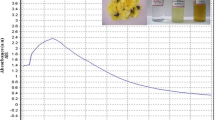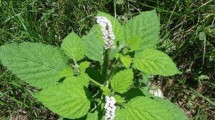Abstract
Green synthesis technology is one of the rapid, reliable and best routes for the synthesis of silver nanoparticles (AgNPs). There are bioactive compounds with enormous potential in Azadirachta indica (Neem). The extraordinary mosquitoes warrant nanotechnology to integrate with novel molecules. This will be sustainable technology for future. Here, we synthesized AgNPs using aqueous extracts of leaves and bark of Az. indica (Neem). We tested AgNPs as larvicides, pupicides and adulticides against the malaria vector Anopheles stephensi and filariasis vector Culex quinquefasciatus. The results were obtained using UV-visible spectrophotometer and the images were recorded with a transmission electron microscope (TEM). The efficacy tests were then performed at different concentrations varying many hours by probit analysis. The synthesized AgNPs were spherical in shape and with varied sizes (10.47-nm leaf and 19.22-nm bark). The larvae, pupae and adults of filariasis vector C. quinquefasciatus were found to be more susceptible to our AgNPs than the malaria vector An. stephensi. The first and the second instar larvae of C. quinquefasciatus show a mortality rate of 100 % after 30 min of exposure. The results against the pupa of C. quinquefasciatus were recorded as LC50 4 ppm, LC90 11 ppm and LC99 13 ppm after 3 h of exposure. In the case of adult mosquitoes, LC50 1.06 μL/cm2, LC90 2.13 μL/cm2 and LC99 2.4 μL/cm2 were obtained after 4 h of exposure. These results suggest that our AgNPs are environment-friendly for controlling malarial and filarial vectors.


Similar content being viewed by others
References
Abbott SW (1925) A method of computing the effectiveness of an insecticide. J Econ Entomol 18:265
Andeani JK, Mohsenzadeh S (2013) Phytosynthesis of cadmium oxide nanoparticles from Achillea wilhelmsii flowers. J Chem. doi:10.1155/2013/147613
Baskaran C, Ratha bai V (2013) Green synthesis of silver nanoparticles using Coleus forskohlii roots extract and its antimicrobial activity against bacteria and fungus. Int J Drug Dev Res 5:114–119
Benelli G, Flamini G, Fiore G, Cioni PL, Conti B (2013) Larvicidal repellent activity of the essential oil of Coriandrum sativum L. (Apiaceae) fruits against the filariasis vector Aedes albopictus Skuse (Diptera: Culicidae). Parasitol Res 112:1155–1161
Conti B, Leonardi M, Pistelli L, Profeti R, Ouerghemmi I, Benelli G (2013) Larvicidal and repellent activity of essential oils from wild and cultivated Ruta chalepensis L. (Rutaceae) against Aedes albopictus Skuse (Diptera: Culicidae), an arvovirus vector. Parasitol Res 112:991–999
Dhanasekaran D, Thangaraj R (2013) Evaluation of larvicidal activity of biogenic nanoparticles against filariasis causing Culex mosquito vector. Asian Pac J Trop Dis 3:174–179
Finney DJ (1971) Probit analysis, 3rd edn. Cambridge University Press, Cambridge
Gavhane AJ, Padmanabhan P, Kamble SP, Jangle SN (2012) Synthesis of silver nanoparticles using extract of neem leaf and triphala and evaluation of their antimicrobial activities. Int J Pharma Bio Sci 3:88–100
Gerberg EJ, Barnard DR, Ward RA (1994) Manual for mosquito rearing and experimental techniques. J Am Mosq Control Assoc 5:98
Gnanajobitha G, Vanaja M, Paulkumar K, Rajeshkumar S, Malarkodi C, Annadurai G, Kannan C (2013) Green synthesis of silver nanoparticles using Millingtonia hortensis and evaluation of their antimicrobial efficacy. Int J Nanomater Biostr 3:21–25
Haldar KM, Haldar B, Chandra G (2013) Fabrication, characterization and mosquito larvicidal bioassay of silver nanoparticles synthesized from aqueous fruit extract of putranjiva, Drypetes roxburghii (Wall.). Parasitol Res 112:1451–1459
Khan M, Khan M, Adil SF, Tahir MN, Tremel W, Alkhathlan HZ, Al-Warthan A, Siddiqui MRH (2013) Green synthesis of silver nanoparticles mediated by Pulicaria glutinosa extract. Int J Nanomed 8:1507–1516
Liu XC, Dong HW, Zhou L, Du SS, Liu ZL (2013) Essential oil composition and larvicidal activity of Toddalia asiatica roots against the mosquito Aedes albopictus (Diptera: Culicidae). Parasitol Res 112:1197–1203
Quelemes PV, Araruna FB, Faria BFED, Kuckelhaus SAS, Silva DAD, Mendonça RZ, Eiras C, Soares MJDS, Leite JRSA (2013) Development and antibacterial activity of cashew gum based silver nanoparticles. Int J Mol Sci 14:4969–4981
Raman N, Sudharsan S, Veerakumar V, Pravin N, Vithiya N (2012) Pithecellobium dulce mediated extra-cellular green synthesis of larvicidal silver nanoparticles. Spectrochim Acta A Mol Biomol Spectrosc 96:1031–1037
Roni M, Murugan K, Panneerselvam C, Subramaniam J, Hwang JS (2013) Evaluation of leaf aqueous extract and synthesized silver nanoparticles using Nerium oleander against Anopheles stephensi (Diptera: Culicidae). Parasitol Res 112:981–990
Senthikumar A, Jayaraman M, Venkatesalu V (2013) Chemical constituents and larvicidal potential of Feronia limonia leaf essential oil against Anopheles stephensi, Aedes aegypti and Culex quinquefasciatus. Parasitol Res 112:1337–1342
Shankar SS, Ahmad A, Sastry M (2004) Rapid synthesis of Au, Ag and bimetallic Au core-Ag shell nanoparticles using neem (Azadirachta indica) leaf broth. J Colloid Interface Sci 15:496–502
Shukla VK, Pandey S, Pandey AC (2009) Green synthesis of silver nanoparticles using neem leaf (Azadirachta indica) extract. Int Conf AdvNanomater Nanotechnol 1276:43
Soni N, Prakash S (2012a) Efficacy of fungus mediated silver and gold nanoparticles against Aedes aegypti larvae. Parasitol Res 110:175–184
Soni N, Prakash S (2012b) Synthesis of gold nanoparticles by the fungus Aspergillus niger and its efficacy against mosquito larvae. Reports Parasitol 2:1–7
Soni N, Prakash S (2012c) Fungal-mediated nano silver: an effective adulticide against mosquito. Parasitol Res 111:2091–2098
Soni N, Prakash S (2012d) Entomopathogenic fungus generated nanoparticles for enhancement of efficacy in Culex quinquefasciatus and Anopheles stephensi. Asian Pac J Trop Dis 2:S356–S361
Soni N, Prakash S (2013) Possible mosquito control by silver nanoparticles synthesized by soil fungus (Aspergillus niger 2587). Adv Nanoparticles 2:125–132
Subarani S, Sabhanayakam S, Kamaraj C (2013) Studies on the impact of biosynthesized silver nanoparticles (AgNPs) in relation to malaria and filariasis vector control against Anopheles stephensi liston and Culex quinquefasciatus say (Diptera: Culicidae). Parasitol Res 112:487–499
Suganya A, Murugan K, Kovendan K, Kumar PM, Hwang JS (2013) Green synthesis of silver nanoparticles using Murraya koenigii leaf extract against Anopheles stephensi and Aedes aegypti. Parasitol Res 112:1385–1397
Tripathi A, Chandrasekaran N, Raichur AM, Mukherjee A (2009) Antibacterial applications of silver nanoparticles synthesized by aqueous extract of Azadirachta indica (Neem) leaves. J Biomed Nanotechnol 5:93–98
Tripathy A, Raichur AM, Chandrasekaran N, Prathna TC, Mukherjee A (2010) Process variables in biomimetic synthesis of silver nanoparticles by aqueous extract of Azadirachta indica (Neem) leaves. J Nanoparticle Res 12:237–246
World Health Organization (2005) Guidelines for laboratory and field testing of mosquito larvicides. WHO/CDS/WHOPES/GCDPP/13
World Health Organization (2006) Vector borne diseases in India. Report of a brainstorming session, 9 November 2006
World Health Organization (2013a) Malaria. http://www.who.int/mediacentre/factsheets/fs094/en/index.html
World Health Organization (2013b) Lymphatic filariasis. http://www.who.int/mediacentre/factsheets/fs102/en/
Yadav A, Mathur P (2013) Studies on antimicrobial activity of nanoparticles of neem extract on groundwater collected from four river samples of India. Int J Adv Pharmaceut Res 4:1676
Zhu L, Tian Y (2013) Chemical composition and larvicidal activity of essential oil of Artemisia gilvescens against Anopheles anthropophagus. Parasitol Res 112:1137–1142
Acknowledgments
We sincerely thank Prof P. S. Satsangi Sahab, Chairman, Advisory Committee on Education, Dayalbagh Educational Institute, and Prof Prem K. Kalra, Director, Dayalbagh Educational Institute, for their support and encouragement. We also thank the UGC, New Delhi, Major Research Project (39-599/2010) for financial support. We also thank Dr. Shashi Wadhawa for access to TEM (AIIMS, New Delhi).
Author information
Authors and Affiliations
Corresponding author
Rights and permissions
About this article
Cite this article
Soni, N., Prakash, S. Silver nanoparticles: a possibility for malarial and filarial vector control technology. Parasitol Res 113, 4015–4022 (2014). https://doi.org/10.1007/s00436-014-4069-4
Received:
Accepted:
Published:
Issue Date:
DOI: https://doi.org/10.1007/s00436-014-4069-4




